The Life Plan (46 page)
Authors: Jeffry Life
Tags: #Men's Health, #Aging, #Health & Fitness, #Exercise, #Self-Help

2.
Keeping your upper arms stationary, lower the dumbbell behind your head, until your elbows form a 90-degree angle.
3.
Press the dumbbell upward until your arms are fully extended and contract your triceps.
ADVANCED DIPS
Benefits:
Exercise for chest, shoulders, and triceps using body weight.
Exercise for chest, shoulders, and triceps using body weight.
To start:
You need to find a dip machine, or parallel bars. Grasp the bar with a tight grip. Make sure you keep your chest up high. Bend your legs to 90 degrees and look forward.
You need to find a dip machine, or parallel bars. Grasp the bar with a tight grip. Make sure you keep your chest up high. Bend your legs to 90 degrees and look forward.
1.
Begin with elbows extended while holding your body in the air.
2.
In a controlled manner lower your body by bending your elbows.
3.
Lower your body until your upper arm is parallel to the floor.
4.
Push your body upward to the starting position by using your triceps, shoulders, and chest.
5.
Stop just before you lock your elbows.
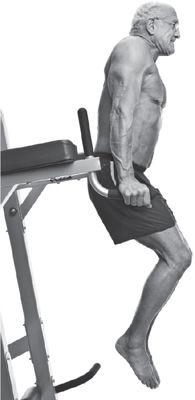
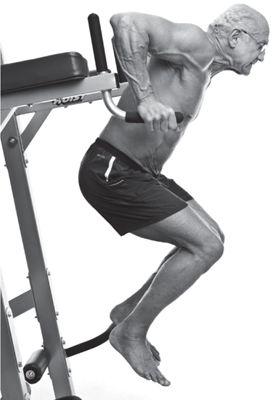
Total-Body/Calisthenics
The following total-body exercises are used in conjunction with the High-Performance Workout. These exercises create a compound set system. An exercise that works a particular muscle group is immediately followed by a full-body exercise that has some emphasis on the same muscle group. For example: On day one a “barbell row, “which works the large muscles in the back, can be immediately followed up with a “crunch to jump pull-up,” which will work the total body, with an emphasis on the larger muscles of the back.
WALKING LUNGE OVERHEAD PRESS
Benefits:
This exercise works the legs, glutes, core, and shoulders.
This exercise works the legs, glutes, core, and shoulders.
Could follow:
Overhead dumbbell press, dumbbell lateral raise, upright row, front raise, rear fly, barbell press (or any shoulder exercise).
Overhead dumbbell press, dumbbell lateral raise, upright row, front raise, rear fly, barbell press (or any shoulder exercise).
To start:
Grab two dumbbells and stand with your feet shoulder width apart and your torso upright. Be sure that you have enough space to walk forward about 20 to 30 feet.
Grab two dumbbells and stand with your feet shoulder width apart and your torso upright. Be sure that you have enough space to walk forward about 20 to 30 feet.
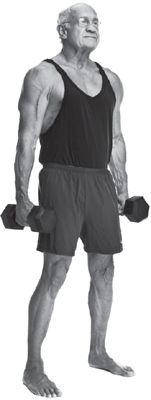
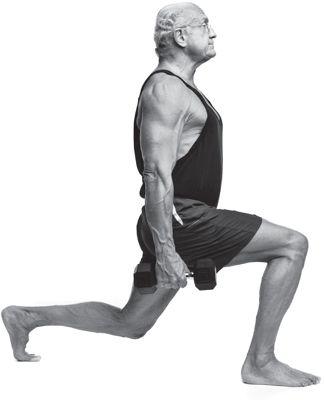

1.
Step forward with your right leg moving around 2 to 3 feet from the foot being left stationary behind, and lower your upper body.
2.
While keeping the torso upright and maintaining balance, do not allow your knee to go forward beyond your toes as you come down. Keep your front shin perpendicular to the floor.
3.
Using mainly the ball of your foot, push up and go back to the starting position.
4.
Lift the dumbbells overhead until your arms are fully extended.
5.
Return dumbbells to their starting position.
6.
Step out with left leg.
DUMBBELL SWINGS
Benefits:
This is a total-body exercise and works all muscles.
This is a total-body exercise and works all muscles.
Could follow:
Overhead dumbbell press, dumbbell lateral raise, upright row, front raise, rear fly, barbell press (or any shoulder exercise).
Overhead dumbbell press, dumbbell lateral raise, upright row, front raise, rear fly, barbell press (or any shoulder exercise).
To start:
Stand with your feet shoulder width apart. Grab a dumbbell and hold it by the end plate with both hands. The dumbbell should be out in front of you and between your legs.
Stand with your feet shoulder width apart. Grab a dumbbell and hold it by the end plate with both hands. The dumbbell should be out in front of you and between your legs.
1.
Keeping feet shoulder width apart, begin by bending your knees slightly.
2.
Pushing your butt back and bending slightly, swing the dumbbell back, between your legs.
3.
Use your hips and legs to swing the dumbbell up, over your head.
4.
In a controlled manner, allow the dumbbell to swing back between your legs.
SQUAT CURL AND PRESS
Benefits:
Total-body exercise that primarily strengthens shoulders, legs, and biceps.
Total-body exercise that primarily strengthens shoulders, legs, and biceps.
Could follow:
Overhead dumbbell press, dumbbell lateral raise, upright row, front raise, rear fly, barbell press (or any shoulder or biceps exercise).
Overhead dumbbell press, dumbbell lateral raise, upright row, front raise, rear fly, barbell press (or any shoulder or biceps exercise).
To start:
Grab two dumbbells and hold them at your side. Your feet should be about shoulder width apart and your torso upright.
Grab two dumbbells and hold them at your side. Your feet should be about shoulder width apart and your torso upright.
1.
Bend your knees until your upper leg is parallel to the floor.
2.
Allow the dumbbells to hang by your side.
3.
Using your legs to return to the starting position, simultaneously perform a biceps curl by flexing your biceps.
4.
Once you are standing erect, lift the dumbbells overhead until your arms are fully extended.
5.
In a controlled manner, lower the dumbbells to their original starting position.
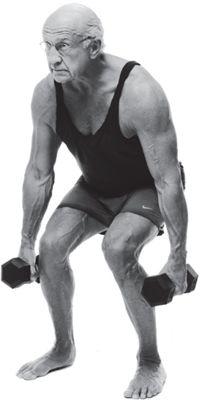
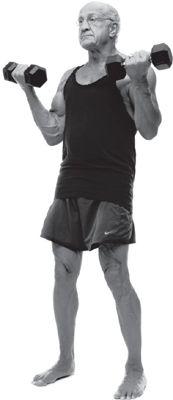

CHAPTER 7
The Life Plan Cardio Workouts
A
erobic exercise isn’t categorized by what you do at the gym; it’s differentiated by how much oxygen you use while you’re moving. Oxygen consumption falls into three categories: aerobic, anaerobic, or a combination of both. Aerobic means “with oxygen” and refers to the use of oxygen in our body’s metabolic or energy-generating processes. Aerobic exercise is any activity that increases the heart rate and uses oxygen while using large muscle groups. It also is maintained continuously and is rhythmic in nature for a prolonged period of time. Aerobic exercise is centered on endurance activities, such as distance running or cycling or distance swimming. Marathon running is almost a purely aerobic exercise.
erobic exercise isn’t categorized by what you do at the gym; it’s differentiated by how much oxygen you use while you’re moving. Oxygen consumption falls into three categories: aerobic, anaerobic, or a combination of both. Aerobic means “with oxygen” and refers to the use of oxygen in our body’s metabolic or energy-generating processes. Aerobic exercise is any activity that increases the heart rate and uses oxygen while using large muscle groups. It also is maintained continuously and is rhythmic in nature for a prolonged period of time. Aerobic exercise is centered on endurance activities, such as distance running or cycling or distance swimming. Marathon running is almost a purely aerobic exercise.
Anaerobic means “without oxygen.” This type of exercise consists of short-lasting, high-intensity activity, where your body’s demand for oxygen exceeds the oxygen supply available. Anaerobic exercise relies on energy sources that are stored in the muscles and, unlike aerobic exercise, is not dependent on oxygen from breathing the air. Anaerobic exercise comprises strength-based activities, such as heavy weight lifting, all types of sprints (running, biking, and so on), jumping rope, hill climbing, interval training, isometrics, or any rapid bursts of hard exercise. Most exercises fall somewhere in between these extremes and include a combination of aerobic and anaerobic activities.
Other books
RavenShadow by Win Blevins
Pleasure for Him by Jan Springer
A Little Tied Up by Karenna Colcroft
How to Be a Submissive Wife by Pearl, Jane
You’re Invited Too by Jen Malone and Gail Nall
Hounded (Shifter Town Enforcement) by Hart, Sadie
The Dark Deeps by Arthur Slade
Sleepover Girls on the Range by Fiona Cummings
Tell the Truth by Katherine Howell
How Beauty Saved the Beast (Tales of the Underlight) by Garren, Jax
